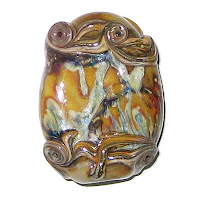I made small beads, and I made sets -- and I made sets with small beads. Whoah. This may seem really silly to people who are already doing this without any problems at all, but I've been stuck in huge bead world for almost two years, and didn't have a clue how to fix it.
The best part is that I figured out that one of my favourite designs (my plasmablossoms) translates really well to a smaller bead. I also figured out that almost all of the nightmares of using a bead press disappear when you use a 1/16" mandrel. The mandrel fits in the press cavity without any rubbing, and the beads just look... well... nicer. I don't know how I'm going to function all week now that I know this! All I want to do is make more beads, but I have to work instead.
I haven't used my 1/16" mandrels very much because I had a BAD EXPERIENCE the first time I went to Andrighetti Glassworks to torch, before I'd taken my first real class. Joanne has the torches on natural gas and tanked oxy, so they're pretty hot, and my heat control was super-newb. I started making a bead and got the shit scared right out of me when part of my mandrel went down and I realized I'd melted the stupid thing apart. I went back to 3/32" mandrels right away and until now, didn't have a compelling reason to take another look at the suicidal scrawny ones.
More recently, I've learned that no matter how warm it seems like it is out there, the middle of February is still a pretty nasty, chilly time to torch outside in Canada. By the time I finished on Sunday, I was like a giant ice cube, had to take a hot shower just to stop shivering, and still didn't feel completely warm again until hours later when I was snuggled into bed.
Every time I look at these beads, I hear a line from Blackadder III, Episode V play in my head, because they are "tiny, and so wee, that I sometimes think the pixies gave them to me!"
I'm out of random, disconnected things to tell you so I'm going to just move on to the pictures. ("Thank God!", they sigh, "I thought she'd never shut up!")
OK, so I didn't make this one on the 1/16" mandrel, but I switched sizes right after I finished it. It's Tamarind Unique #2 with a twistie made from Thüringen Herb, Red Copper Green, Triton and TerraNova2. I think I rolled it in silver foil first, and after it was all shaped and polished and stuff, I did the random SiS swirly thing around the ends.
I did a little dance when I pulled this out of the kiln because it confirmed that I can shrink this design significantly and still preserve all of the things I like about it. This one is Pale Ink Blue encased with Magic, the flowers are Ivory and the surface decoration is Ivory and SiS.
And holy carp, I made a set. It even has more than three beads in it. I was so pleased with myself on Sunday that I thought I might cry. It's Tamarind Unique #2, with silver foil, silver wire, Copper Green and silver glass frit.
The most hilarious thing about this set is that even when I put all the beads together in a line, the whole thing isn't as long as one of the gargantuan beads I made last weekend all by itself. lol.
And finally, here are some fun beads, with much less in the way of babble accompanying them. I need to get some sleep or I won't be able to retain this great mood I'm in.
Tamarind Unique #2, Silver Foil, Silver Glass Frit
Tamarind Unique #2, SiS, Copper Green, Silver Glass Frit
Pale Ink Blue, Magic, Ivory, Clear
Cocoa, Ivory, Copper Green




















































